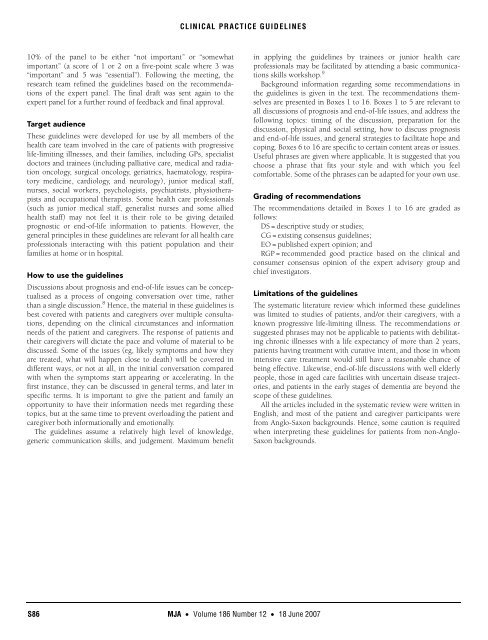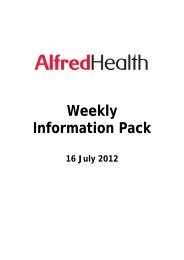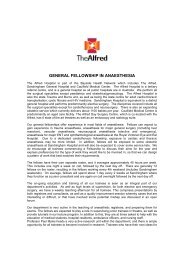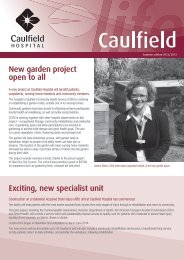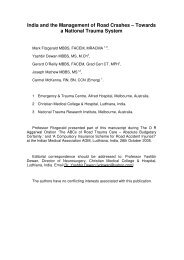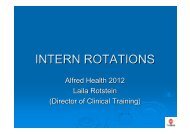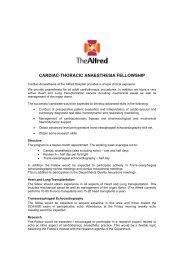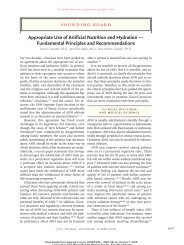COMMUNICATING PROGNOSIS AND END-OF-LIFE ISSUESGuideline development and useDiscussing prognosis and end-<strong>of</strong>-life issues has been identified asan important component <strong>of</strong> care by patients with progressive lifelimitingillnesses, and their families. 1,2 Being adequately informedis essential for such patients and their caregivers to participate indecisions about their treatment and care, to set goals and priorities,and to prepare for death. Clinicians need to provide information ina way that assists patients and their families to make appropriatedecisions, be informed to the level that they wish, and cope withtheir situation. <strong>The</strong>se guidelines have been prepared to assistclinicians with this difficult but important task.Methods <strong>of</strong> guideline development<strong>The</strong> guidelines were developed using the following process:• Literature review:‣ systematic review <strong>of</strong> the best available evidence regardingdiscussion <strong>of</strong> prognosis and end-<strong>of</strong>-life issues with patientswith a progressive life-limiting illness, and their caregivers;and‣ review <strong>of</strong> previous related guidelines and expert opinions.• Refining <strong>of</strong> guidelines with an expert advisory panel.Literature reviewSystematic review<strong>The</strong> systematic review 3 was conducted in conjunction with personnel<strong>of</strong> the systematic review section <strong>of</strong> the National Health and<strong>Medical</strong> Research Council (NHMRC) Clinical Trials Centre, inaccordance with the principles and processes recommended by theCochrane Review. 4 Eligible studies were those that sampled adultpatients who had an advanced progressive life-limiting illness withless than 2 years to live, including but not restricted to cancer, endstagepulmonary disease, end-stage cardiac failure, and motorneurone disease; and/or the caregivers (including bereaved relatives)<strong>of</strong> such patients; and qualified health care pr<strong>of</strong>essionals.More specifically for studies where patients formed the studygroup, the eligibility criteria included: patients in specialist palliativecare or hospice settings (inpatient or community), andpatients in any care setting with a diagnosis <strong>of</strong> an advanced lifelimitingillness being treated with palliative intent and with a lifeexpectancy <strong>of</strong> less than 2 years. Where samples were mixed (ie,potentially curable and advanced disease), studies were included ifmore than 50% <strong>of</strong> patients had an advanced life-limiting illness orwhere the results for such patients were provided separately.Studies where patients formed the study group were excluded ifthey involved patients with chronic diseases with likely lifeexpectancy <strong>of</strong> greater than 2 years (such as dementia and multiplesclerosis), patients being treated with curative intent, or patientsbeing cared for in an intensive care unit, or if it was not possible todetermine what percentage <strong>of</strong> the study group was being treatedwith palliative intent or had a life expectancy <strong>of</strong> less than 2 years.<strong>The</strong> medical literature was searched to identify relevant studiesand reviews for the period between 1966 and November 2004.Searches were conducted via MEDLINE, CINAHL, EMBASE,Psycinfo and the Cochrane Register <strong>of</strong> Controlled trials (Central).Out <strong>of</strong> 4167 abstracts retrieved by electronic searches, and afurther 127 abstracts identified by hand searching, 278 fullmanuscripts were considered for inclusion in the review. Onehundred and fifty-one did not meet the eligibility criteria and fourwere duplicates; hence, 123 articles were included. Individualreviewers extracted data from each study using a standard format.Data extraction was checked by a second reviewer for 10% <strong>of</strong>studies to ensure consistency.Most studies were descriptive, examining provider practices andpatient and/or caregiver views, attitudes, knowledge and behaviour(Level IVa evidence according to the NHMRC 1995 ratings 5 ).Such studies are not considered admissible evidence in the morerecent NMHRC rating scale. 6 <strong>The</strong>se NHMRC rating scales aredesigned for research questions regarding interventions, diagnosis,aetiology, screening and prognostic factors, but are not readilyapplicable to the topic <strong>of</strong> these guidelines.Review <strong>of</strong> consensus guidelines and expert opinionRelevant consensus guidelines and expert opinion were incorporatedinto the guidelines because <strong>of</strong> the lack <strong>of</strong> evidence for sometopics. Consensus guidelines in similar areas were retrieved viahand searching and the search strategy for the systematic review.<strong>The</strong>y were excluded from the systematic review because they werenot studies. <strong>The</strong>se guidelines included areas such as breaking badnews (n = 2), psychosocial clinical practice guidelines for womenwith breast cancer (n = 1), clinical practice guidelines for advancedbreast cancer (n = 1), therapeutic guidelines for palliative care (n =1),advance directives (n = 1) and end-<strong>of</strong>-life care (n = 1). <strong>The</strong>se guidelinesused a rigorous consensus-building process, with manycommissioned by the <strong>Australia</strong>n or New South Wales Governmentand endorsed by national peak bodies. Published expert opinion— the considered opinion <strong>of</strong> clinical experts (n = 12) regardingcommunication <strong>of</strong> prognosis and end-<strong>of</strong>-life issues with patients,and their families, with advanced life-limiting illnesses — wasreviewed and cited for areas where there was a lack <strong>of</strong> studies orconsensus.Expert advisory panelAn expert panel was convened, comprising 35 <strong>Australia</strong>n and NewZealand health care pr<strong>of</strong>essionals and consumers (nine palliativecare medical specialists, three medical oncologists, three palliativecare nurses, three consumers [including two cancer patients andone caregiver], two general practitioners, two psychosocial experts,two ethicists, two linguists, one oncology nurse, one cardiologynurse, one aged care nurse, one research nurse, one geriatrician,one respiratory physician, one radiation oncologist, one intensivecare specialist, and one lawyer). <strong>The</strong> panel members were selectedto reflect the multidisciplinary nature <strong>of</strong> care for patients withadvanced progressive life-limiting illnesses. Representatives wereselected on the basis <strong>of</strong> either their clinical expertise or a trackrecord <strong>of</strong> publications on this topic. Consumer bodies, such asCarers NSW and Cancer Voices NSW, were approached andprovided consumer representation. <strong>The</strong> guidelines were refinedwith the assistance <strong>of</strong> this expert panel using consensus methods(modified nominal group technique/Delphi method 7 ).This group was sent the guidelines by mail and asked to evaluatethem (both by rating each individual point using a nominal scaleand by providing suggested word changes and comments followingcritical review). <strong>The</strong> group then had a face-to-face meeting anddiscussed discrepancies <strong>of</strong> opinion and all items rated by at leastMJA • Volume 186 Number 12 • 18 June 2007S85
CLINICAL PRACTICE GUIDELINES10% <strong>of</strong> the panel to be either “not important” or “somewhatimportant” (a score <strong>of</strong> 1 or 2 on a five-point scale where 3 was“important” and 5 was “essential”). Following the meeting, theresearch team refined the guidelines based on the recommendations<strong>of</strong> the expert panel. <strong>The</strong> final draft was sent again to theexpert panel for a further round <strong>of</strong> feedback and final approval.Target audience<strong>The</strong>se guidelines were developed for use by all members <strong>of</strong> thehealth care team involved in the care <strong>of</strong> patients with progressivelife-limiting illnesses, and their families, including GPs, specialistdoctors and trainees (including palliative care, medical and radiationoncology, surgical oncology, geriatrics, haematology, respiratorymedicine, cardiology, and neurology), junior medical staff,nurses, social workers, psychologists, psychiatrists, physiotherapistsand occupational therapists. Some health care pr<strong>of</strong>essionals(such as junior medical staff, generalist nurses and some alliedhealth staff) may not feel it is their role to be giving detailedprognostic or end-<strong>of</strong>-life information to patients. However, thegeneral principles in these guidelines are relevant for all health carepr<strong>of</strong>essionals interacting with this patient population and theirfamilies at home or in hospital.How to use the guidelinesDiscussions about prognosis and end-<strong>of</strong>-life issues can be conceptualisedas a process <strong>of</strong> ongoing conversation over time, ratherthan a single discussion. 8 Hence, the material in these guidelines isbest covered with patients and caregivers over multiple consultations,depending on the clinical circumstances and informationneeds <strong>of</strong> the patient and caregivers. <strong>The</strong> response <strong>of</strong> patients andtheir caregivers will dictate the pace and volume <strong>of</strong> material to bediscussed. Some <strong>of</strong> the issues (eg, likely symptoms and how theyare treated, what will happen close to death) will be covered indifferent ways, or not at all, in the initial conversation comparedwith when the symptoms start appearing or accelerating. In thefirst instance, they can be discussed in general terms, and later inspecific terms. It is important to give the patient and family anopportunity to have their information needs met regarding thesetopics, but at the same time to prevent overloading the patient andcaregiver both informationally and emotionally.<strong>The</strong> guidelines assume a relatively high level <strong>of</strong> knowledge,generic communication skills, and judgement. Maximum benefitin applying the guidelines by trainees or junior health carepr<strong>of</strong>essionals may be facilitated by attending a basic communicationsskills workshop. 9Background information regarding some recommendations inthe guidelines is given in the text. <strong>The</strong> recommendations themselvesare presented in Boxes 1 to 16. Boxes 1 to 5 are relevant toall discussions <strong>of</strong> prognosis and end-<strong>of</strong>-life issues, and address thefollowing topics: timing <strong>of</strong> the discussion, preparation for thediscussion, physical and social setting, how to discuss prognosisand end-<strong>of</strong>-life issues, and general strategies to facilitate hope andcoping. Boxes 6 to 16 are specific to certain content areas or issues.Useful phrases are given where applicable. It is suggested that youchoose a phrase that fits your style and with which you feelcomfortable. Some <strong>of</strong> the phrases can be adapted for your own use.Grading <strong>of</strong> recommendations<strong>The</strong> recommendations detailed in Boxes 1 to 16 are graded asfollows:DS = descriptive study or studies;CG = existing consensus guidelines;EO = published expert opinion; andRGP = recommended good practice based on the clinical andconsumer consensus opinion <strong>of</strong> the expert advisory group andchief investigators.Limitations <strong>of</strong> the guidelines<strong>The</strong> systematic literature review which informed these guidelineswas limited to studies <strong>of</strong> patients, and/or their caregivers, with aknown progressive life-limiting illness. <strong>The</strong> recommendations orsuggested phrases may not be applicable to patients with debilitatingchronic illnesses with a life expectancy <strong>of</strong> more than 2 years,patients having treatment with curative intent, and those in whomintensive care treatment would still have a reasonable chance <strong>of</strong>being effective. Likewise, end-<strong>of</strong>-life discussions with well elderlypeople, those in aged care facilities with uncertain disease trajectories,and patients in the early stages <strong>of</strong> dementia are beyond thescope <strong>of</strong> these guidelines.All the articles included in the systematic review were written inEnglish, and most <strong>of</strong> the patient and caregiver participants werefrom Anglo-Saxon backgrounds. Hence, some caution is requiredwhen interpreting these guidelines for patients from non-Anglo-Saxon backgrounds.S86 MJA • Volume 186 Number 12 • 18 June 2007


